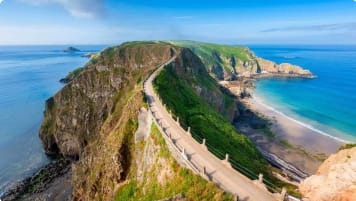British Villages icons: The Definitive Guide
Icons of the British Villages: Pubs and Cottages The British pub and cottage figure prominently in the image of a (often romanticised) quintessential “British village”. In this article, we will give special attention to these…
9 Oct 19 · 12 mins read
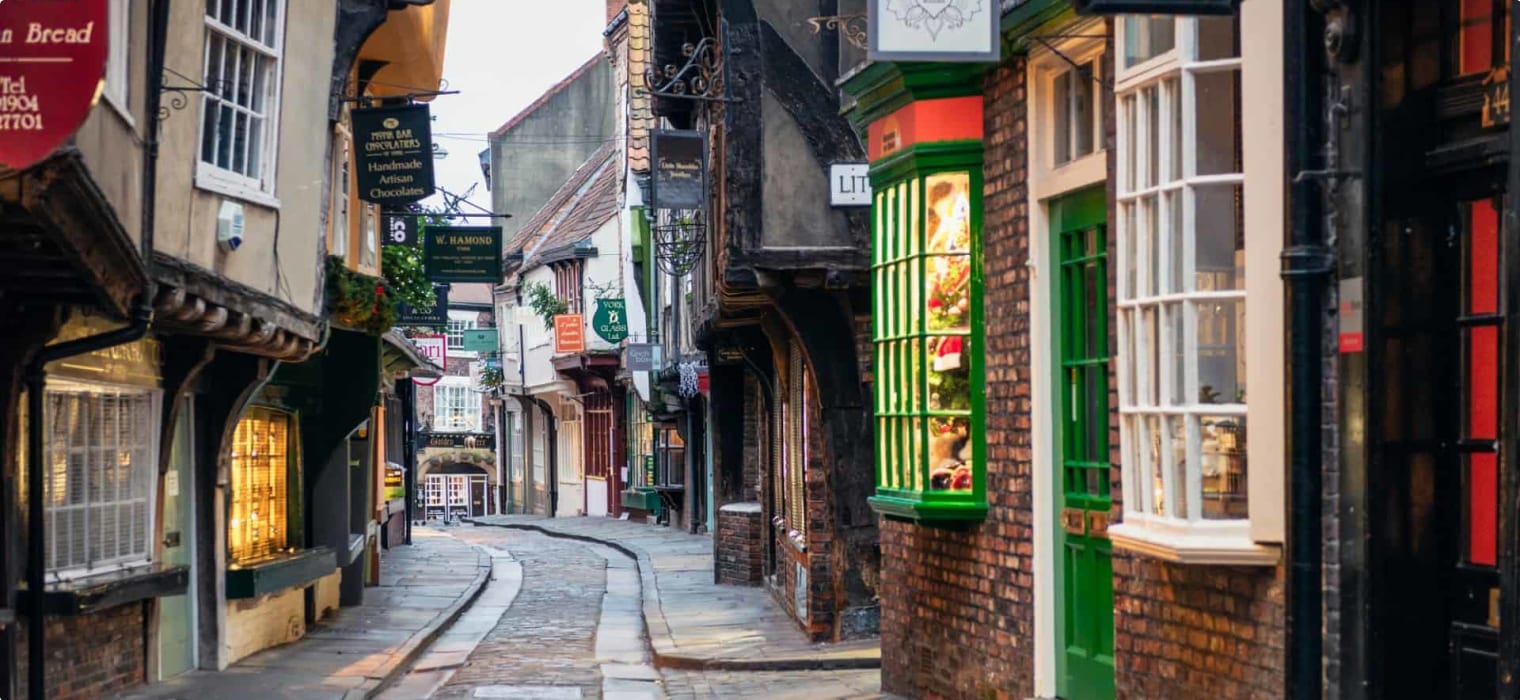
Icons of the British Villages: Pubs and Cottages
The British pub and cottage figure prominently in the image of a (often romanticised) quintessential “British village”. In this article, we will give special attention to these structures–particularly the origins of the pub in Roman times and how the “classic” British cottage evolved from the reconfiguration of the village during the Norman invasion.
Mary-Ann Ochota’s Hidden Histories: A Spotter’s Guide to the British Landscape (Francis Lincoln, 2016) is an essential reference guide for this article; other resources are linked throughout. You may also want to read our previous articles on the history of the British village and on how to read the British landscape.
From the Roman Tabernae to the British Pub
The development of agriculture during the Neolithic era (starting circa 4500 BC) had an enormous impact on human society. The people living in prehistoric Britain were hunter-gatherers, which meant they covered a lot of ground and moved from place to place to forage for food, but agriculture “tied people to one place” (Ochota, 2016, p. 190) and triggered the desire to create more permanent dwellings. There were two kinds of settlements that developed during prehistory in the British Isles: the farmstead, composed of a dwelling surrounded by farmland, and the hamlet, a cluster of about a dozen dwellings with shared fields, but they were not organised and simply developed organically.
Enter the invading Roman army, with their roads and plans and straight lines. Hundreds of years before they arrived in Britain in 43 AD, the Romans were already residing in urban centres with facilities that resembled modern amenities: they developed the aqueduct in 312 BC, supporting public latrines and baths, underground sewage systems, and fountains, and lived in buildings called insulae, which resembled modern apartment blocks, averaging four to five stories. (Read more about the Roman Empire in our article here.) Once in Britain, they started building roads and laid out military sites in rectilinear grids (p. 191). However, the vici, or civilian settlements, that grew next to the military sites were more free-form (p. 191).
The Romans also established the institution that would later become the local pub, or public house. The tabernae, or single-room retail shops, were common within the Roman empire, fronting insulae and even domestic houses. The tabernae fronting private homes were found on either side of the doorway entrance and were sometimes rented to vendors not related to the family living in the home [Lindenmier, n.d.]), helping upper-class Roman widows earn some income.
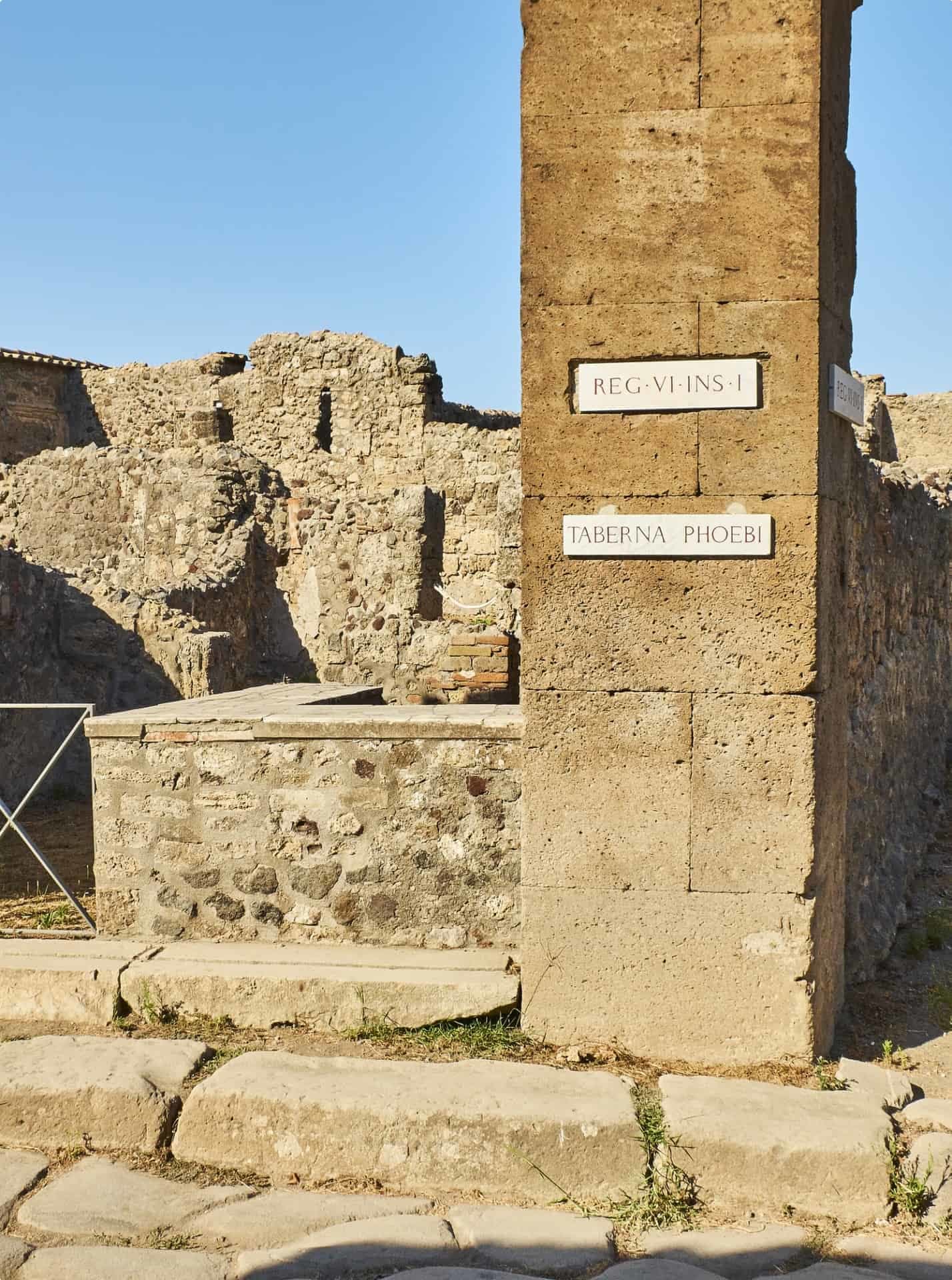
The Romans brought the retail shops to Britain, selling wine–and later, ale, a native brew–as well as food to troops and vici residents. They marked the retail shops with a pole “hung with vine or ivy leaves” (Ochota, 2016, p. 202), a practice that continued well into the Middle Ages in the form of the ale pole indicating that the drinking house had fresh brew.
When the Germanic Angles, Saxons, and Jutes (collectively, Anglo-Saxons) inhabited and ruled Britain in the 5th to 11th centuries, tabernae became taverne (Anglo-French) became “tavern”.
Taverns, Alehouses, and Inns
Taverns and alehouses (from the Saxon ealuhus) became common in Britain during the Anglo-Saxon period, with people opening their homes to sell food and drink. Taverns historically specialised in wine while alehouses, as the name suggests, sold ale. Ale was made without hops, or the ingredient that makes a drink bitter. When hops were added to ale in the 15th century, it became known as beer.
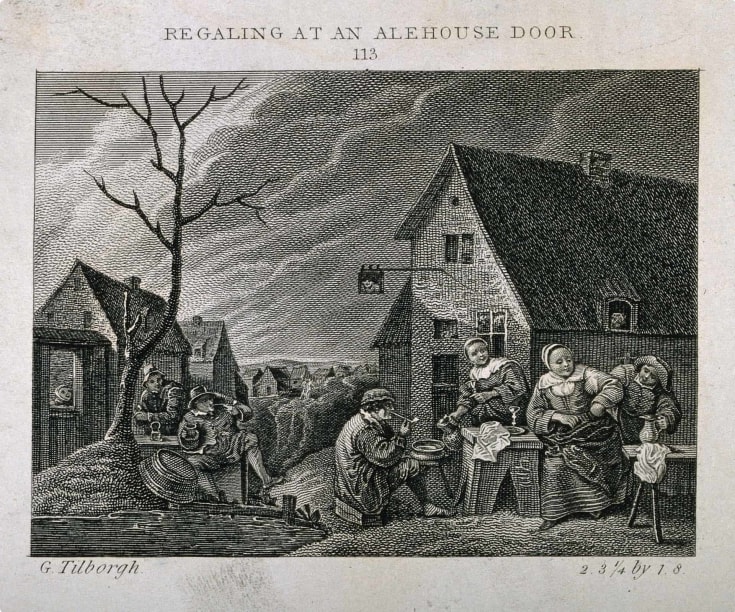
Inns, in addition to providing food and drink, also provided accommodation and were popular among travellers. Here we can see the origin of the term pub or “public house”. The term itself–used to refer to taverns, alehouses, and inns–only became popular in the 17th century, with the slang “pub” a recent invention, used in the late 19th century. Ye Olde Fighting Cocks in Hertfordshire, dating back to the 8th century, is said to be the oldest pub in Britain.
Coaching inns developed in response to the creation of regular stagecoach services in the 16th century, where travellers took long drives (three days by stagecoach from London to Bath) to travel from one town to another. Shares Ochota (2016, p. 202), “[C]oaching inns were regular stops for stagecoaches carrying passengers and mail between major towns and cities.” She says you can identify these “now often converted” (p. 202) coaching inns by their courtyard entrance-ways, which would have clearance high enough for a horse-drawn carriage, as well as a range of buildings once used by groomsmen and as horses’ stables with drinking troughs.
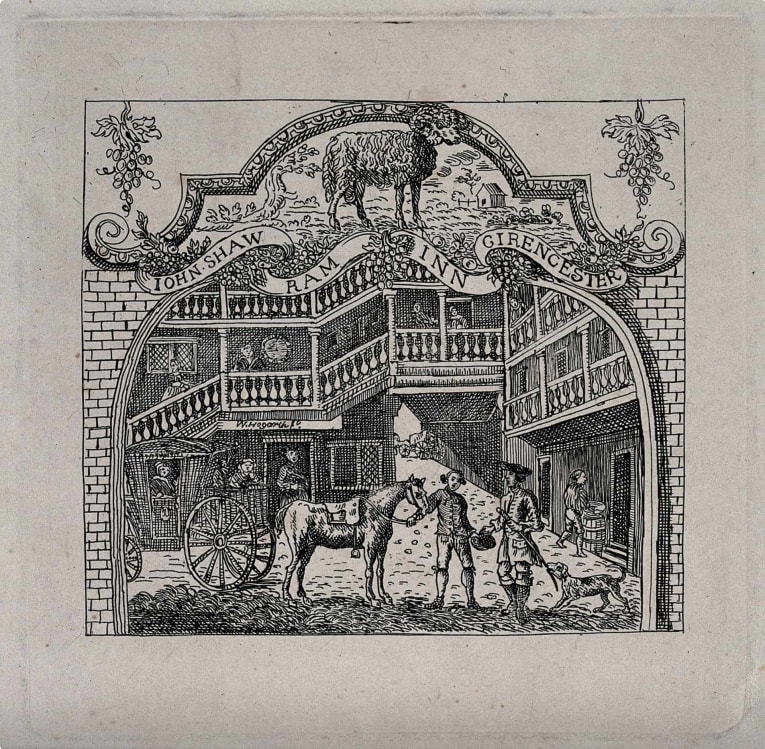
Pub Signs
Due to the pubs’ immense popularity (and rapidly growing number), the Crown introduced policies to control their quality. In the 12th century, pub signs were simple symbols representing alcoholic drinks (e.g. picture of a tankard) to tell the public, majority of whom at the time were illiterate, that there were drinks that can be bought inside. This changed when in 1393, Richard II decreed that “Whosoever shall brew ale in the town with intention of selling it must hang out a sign, otherwise he shall forfeit his ale.” The sign also served to alert the roving Ale Taster, an official appointed to inspect the quality of alcohol being sold in the establishment. The original rule required that the pubs use the king’s emblem, a white hart, but the sheer number of pubs required a diversity of symbols and colours. This is why to this day pub signs are very memorable, colourful, and eye-catching, as it allowed the establishments to announce their distinct identity to both the Ale Taster and the drinking public.
According to James Hunt (2015), succeeding monarchical policies affected the pub signs. In 1532, Henry VIII named himself Head of the Church of England and separated from the Roman Catholic Church, and so pubs responded by moving away from religious iconography (radical Protestant forces saw iconography as idolatry) and using royal figures instead. For example, pubs named “Pope’s Head” became “King’s Head” (Ochota, 2016, p. 203). In 1603, James I, whose reign united England and Scotland under one crown, ordered that a Scottish emblem–the red lion–appear on buildings, including pubs. The orders of these two kings resulted in Britain having “The Crown” and “The Red Lion” as the most common pub names.

The aforementioned Ye Olde Fighting Cocks also changed its name several times. It was originally called “The Round House” but was renamed “Ye Olde Fighting Cocks” when it gained a cock pit. Cock fighting was a national pastime in England from the reign of Henry II, but when the practice was banned in 1849, the pub changed its name to “The Fisherman”. It reverted back to the name we know now in 1872.
Pubs began to resemble the British pub as we know it today in the 19th century, especially with the passing of the Beer Act in 1830. The pub is a British institution, with more than 55,000 operating in Britain (Ochota, 2016, p. 202).

British Cottages
Having looked at the British pub, let’s take a step back and see what happened to the village after the Romans left.
After the Romans left and the Anglo-Saxons arrived, dwellings returned to the pre-Roman farmstead and hamlet formations. Plots, usually for churches, followed a grid-plan using a standardised unit of measurement called “perch”–around 15 feet or 4.6 metres (p. 193). The 7th century All Saints Church in Brixworth, Northamptonshire fits the four-perch grid plan, according to Ochota.
But the “classic” British village as we know it today–a beautiful collection of cottages facing the village green or an idyllic street–began its development during the invasion of the Normans, who succeeded the Anglo-Saxons in the 11th century. Dispersed hamlets were reconstructed in order to focus and centralise the labour force on farming land, usually owned by a landed noble living in a manor. Ochota (2016, p. 194) cites the reconstruction of a 12th century medieval village in Cosmeston near Cardiff which features this layout: houses built around the manor house and farm.
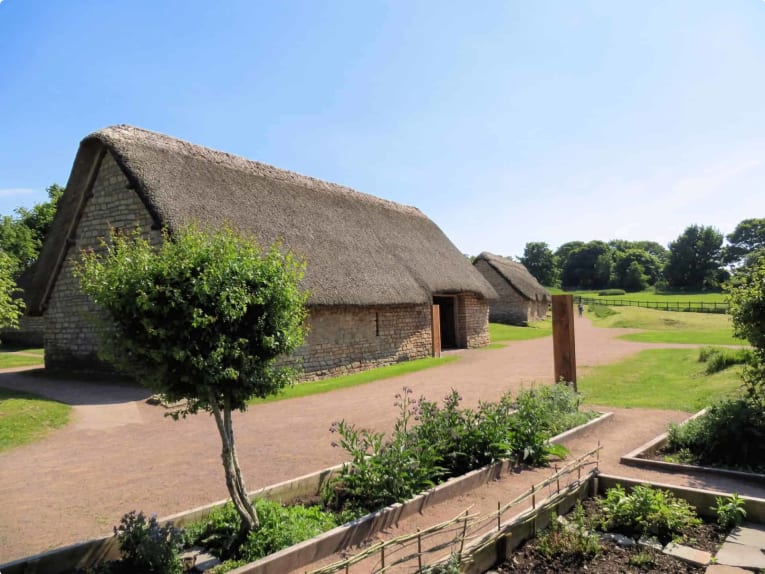
The village green, a communal piece of land used for markets or fairs or as grazing land, became more widespread in the 12th century with the awarding of new market charters (p. 204). After the Norman Conquest, the right of a town to hold markets and fairs was controlled by the Crown. These weekly and annual events attracted people and revenue, and thus promoted economic growth. They also provided revenue to the Crown in the form of taxes and tolls, hence the need for these events to go through royal regulation. Market Drayton in Shropshire, England carries the importance of its 1245 market charter in its very name (p. 201).
Vernacular Buildings
Let’s look at the cottages. Norman-built villages are called “toft-and-croft plots” (p. 194), which is composed of “a cottage with private yard space, veg patch and animal pens”, a familiar layout to modern eyes. Cottages were built using materials that were readily available in the area: an area with good building stone would have stone cottages, and an area with abundant local timber would have timber-framed cottages. If an area had neither, builders would use compacted earth (p. 206).
This is called vernacular architecture, wherein structures are built using traditional designs and local materials, responding to the particular needs of the house’s inhabitants and the climate of the region. The stress is on function instead of individual style. This concept of architectural theory is in contrast with what is called “polite architecture”, whose definition sounds like the mainstream architectural practice we know today:
Polite architecture is the term used to describe buildings that incorporate non-local styles and use designed features that go beyond functional requirements. These stylistic features may be used by the architect to make a particular statement or to achieve an aesthetically-pleasing effect.
We will return to this concept of polite architecture later in the article.
Sarah Edwards, writing for Arch Daily, calls vernacular architecture the “simplest form of addressing human needs…It is a pure reaction to an individual person’s or society’s building needs, and has allowed man, even before the architect, to construct shelter according to his circumstance.”
Against the backdrop of industry, vernacular buildings may appear simple and “low-tech”. But vernacular buildings are still being built. In the US, barns still follow the design used in Europe in the 1st millennium BC.
Stone
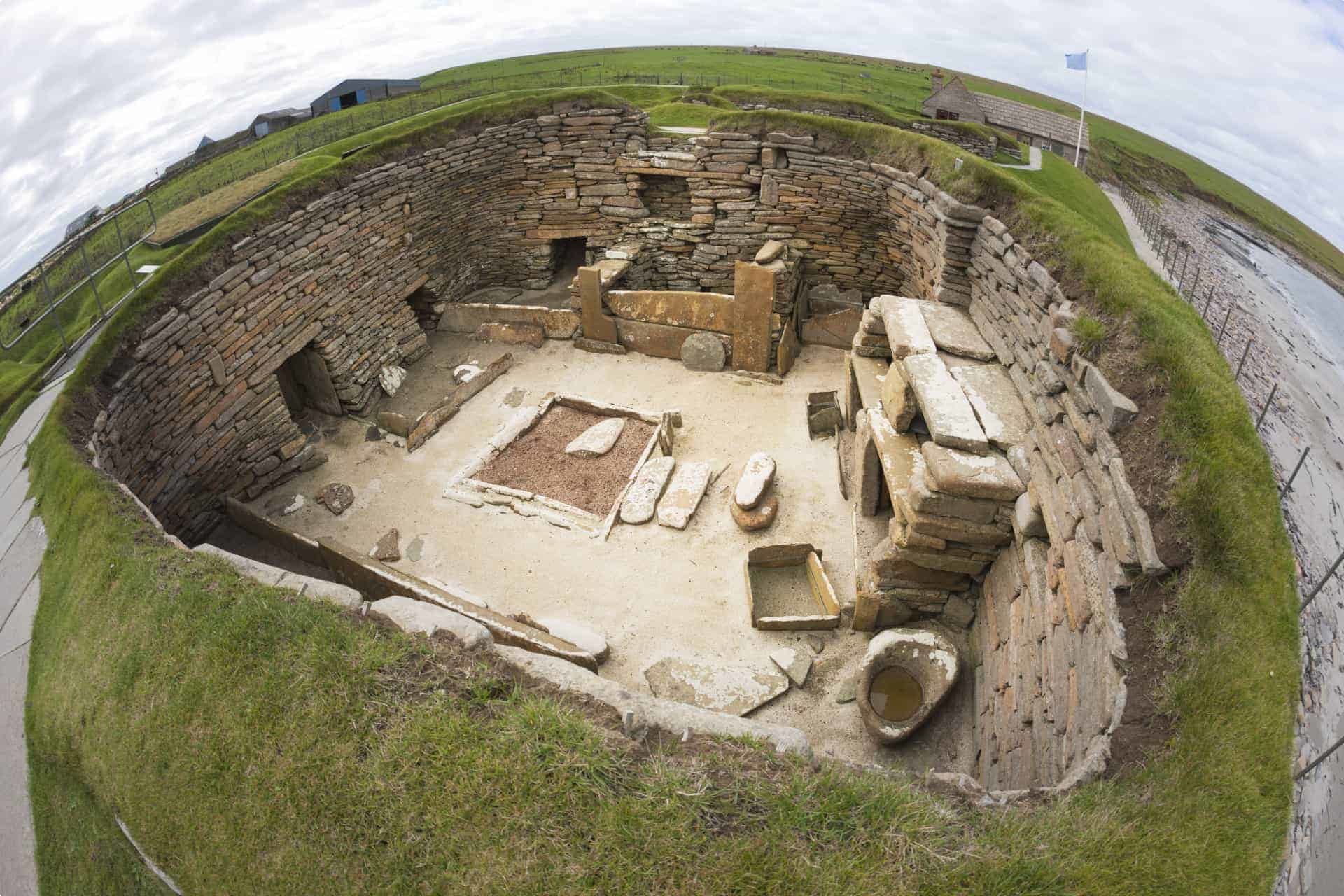
The earliest surviving houses in Britain date back to the Neolithic and can be found in Orkney (Ochota, 2016, p. 207). The Skara Brae dwellings were made of stone, preserved under sand for 4,000 years, and rediscovered after a storm. Each of the eight houses, connected by passageways, had an identical layout: a central hearth for the fire, a stone dresser positioned opposite the door to be illuminated by firelight and light coming through the entrance, and, as Sigurd Towrie describes, “a large block that was almost certainly a seat. Was this a seat of honour for the most venerated member of the household?” We can only surmise.
Timber
In general, according to Ochota (2016, p. 207), surviving cottages lived in by peasants date from the mid-17th century, while older houses still standing are “the grandest rural houses in their time”–which may still be owned by peasants, as the term refers to a person who lived off of the products of his or her own labour, not necessarily someone who lived in extreme poverty. As Ochota describes, truly humble peasant dwellings often didn’t last past the two-decade mark, and were rebuilt using the same materials, if salvageable. Most of them also didn’t have windows as most of the peasant’s work–cooking, repairing tools–were done outside in daylight (p. 207).
This period in the 17th century is called the “vernacular threshold“, the point after which ordinary people began building houses with material and design sturdy enough to survive to this day. Some historians are studying whether that threshold came earlier, as some vernacular cottages in the counties of Buckinghamshire, Leicestershire, Oxford, and Warwick were found to have been built around the 13th century.
Timber was used immediately after it was felled (p. 210), as opposed to reducing the moisture content of the wood before use, which is now common in modern practice. In England, there are two main timber framing traditions dating back to medieval times: the cruck frame and the box frame (p. 210).
With the cruck frame, carpenters used pairs of timbers (called “blades”) to form an A-frame that would carry the weight of the roof down to ground level.

The cruck frame style is “commonly seen across northern, western and midland England but almost unknown in East Anglia and the south-east”, according to Historic England. Cruck frames were used in high-status buildings before the 1500s and by poorer cottages in later years, particularly in northern England, when the style went out of fashion with the wealthy (Ochota, 2016, p. 210).
The more common box frame tradition, on the other hand, features vertical and horizontal timbers to create the frame of the house, with panels filled with wattle-and-daub. Using this method of wall construction, wattles, or wooden stakes, were set into a hole bored in a horizontal timber above and fitted into a groove in a corresponding timber below, and covered with clay or mud.
Another common wall-building technique was cobbing, using a mixture of compressed clay and straw called cob, with the straw acting as a binding agent. The mixture would be poured onto a stone foundation and dried and sculpted by layer.
Decorative framing using square panels (small framing) and vertical panels (close studding), which required more wood and more manpower hours (and hence were more expensive), became a trend in the 1450s and reached the height of popularity during the Elizabethan age (p. 212). Pargeting, or decorative plasterwork applied to walls, became popular in the 17th century and experienced a revival during the 19th century Arts and Crafts movement (p. 217).

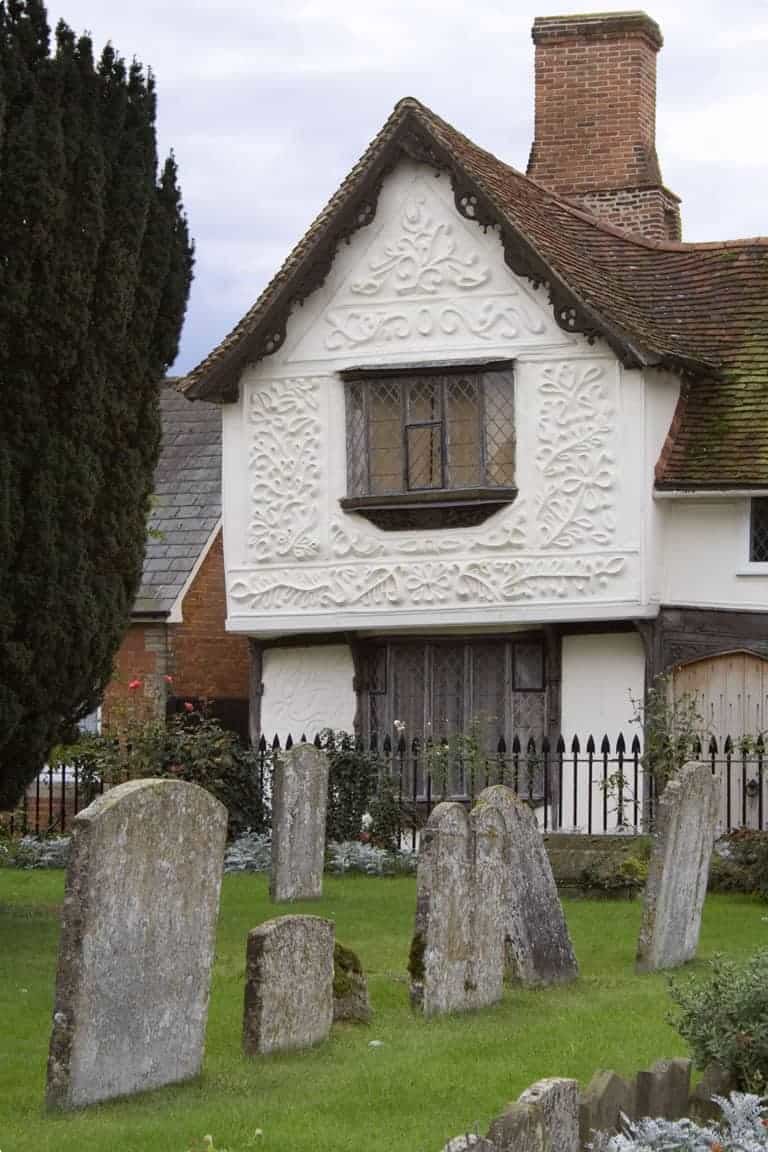
Timber-framing was also revived in the 19th century, as evidenced by the striking black-and-white framed “Tudor” cottages built in this style even after the reign of the Tudors.
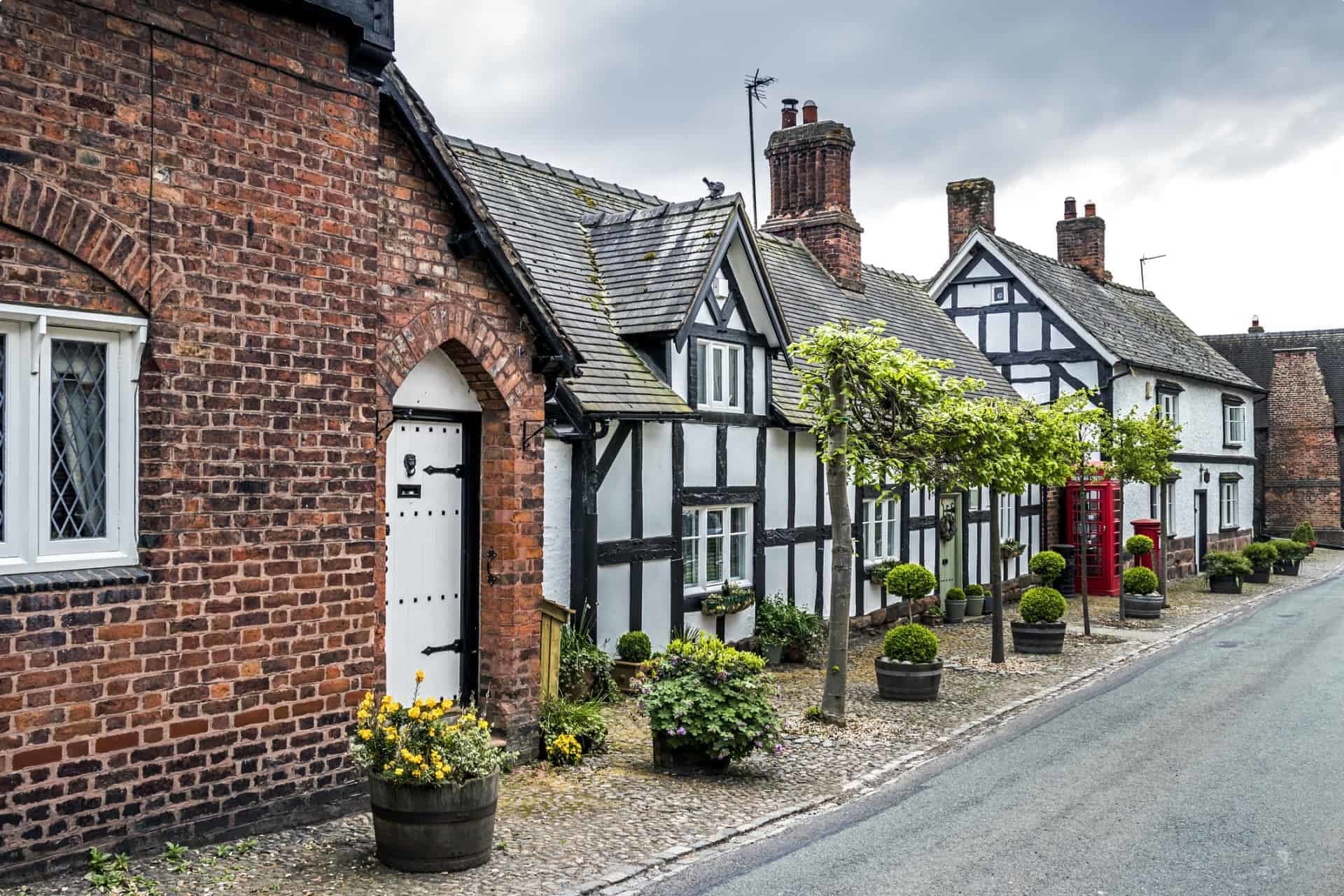
Roofing Materials
Since housing materials were lightweight and irregular, the cottages needed equally lightweight roofing materials. Thatch, or a roof covering made of straw, reed, or similar material, was the most common roof covering in Britain until the 1800s (Ochota, 2016, p. 222).
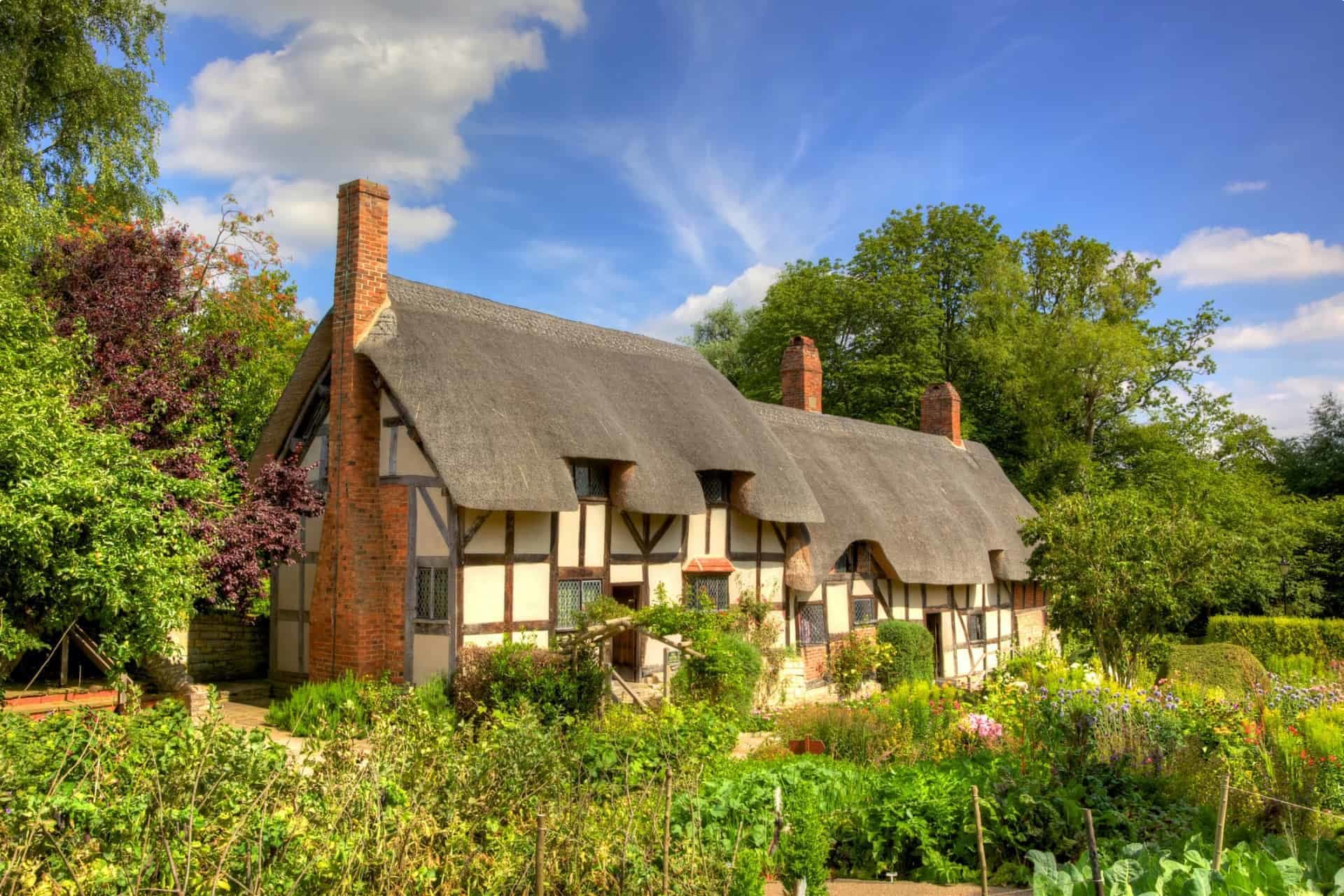
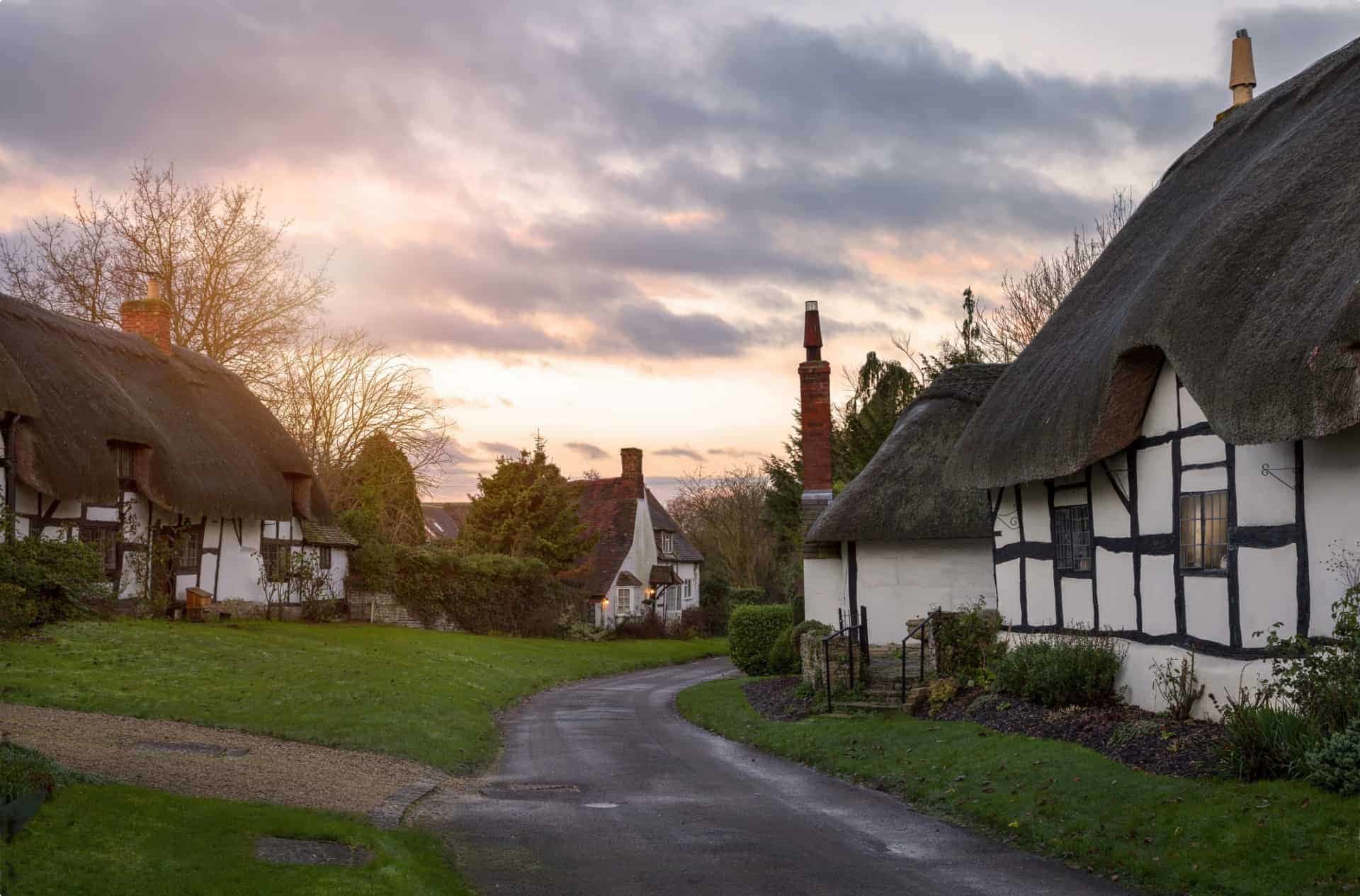
During and after the 1800s, many of these thatched cottages were re-roofed with tiles, and you can tell this by comparing the “unthatched” house to the other houses in the row–if the roofline of the house was lower, it probably lost that height after re-roofing as thatch was thicker (p. 223).
“Polite” Cottages
We have defined polite architecture earlier. How did it come about? There were several factors: the demands of the wealthy (who could afford to focus on individual style instead of, or other than, function, when designing their homes), the professionalisation of the field of architecture, and the mass production and transport of building materials. In Britain, it became the practice during the Georgian and Victorian periods. Vernacular homes were torn down to build “polite” cottages which followed a standardised architectural plan, down to the spacing between each house (p. 228).
A return to regional traditions and a move to preserve the history and legacy of the humble vernacular home was a relatively recent phenomenon. Two of the examples here–Palmer’s Farm and Anne Hathaway’s Cottage–remain standing thanks to the Shakespeare Birthplace Trust, an independent charity that looks after the Shakespeare heritage sites in Stratford-upon-Avon, and thereby preserving the 15th and 16th century homes. In 1965, Britain’s The Landmark Trust was founded with the aim of sensitively restoring and furnishing historic buildings, including cottages, so they can inspire the generations to come.
If you want to learn more, we once again recommend Mary-Ann Ochota’s Hidden Histories: A Spotter’s Guide to the British Landscape (Francis Lincoln, 2016) as well as the other resources linked throughout this piece.
You may also consider joining one of Odyssey Traveller’s many tours to the British Isles, such as the Villages of England tour we’ve mentioned earlier. The 19-day fully escorted tour will let you explore from our well-appointed hotel the history and culture of the British countryside. This tour takes us to the stone circles and henge monument at Avebury, the famous Lake District, the white-washed, thatched-roofed cottages of Milton Abbas, the traditional village buildings of Sussex, the rolling hills of Dartmoor, England’s most photographed bridge in Ashford-in-the-Water, and the delightful coastal village of Port Isaac. We stroll through the villages on Cornwall’s coast, and view the castle towering over the cobblestoned main street of Dunster. All of this will offer a panoramic and revealing portrait of England’s villages.
Another tour that may be of interest is the Prehistoric Britain tour, which visits Skara Brae and other historic sites in Orkney, Shetland, and Wales. This tour will let you discover hidden gems and amazing landscapes.
Be inspired by our memorable tours on offer. For more information on all of our tours to the British Isles, click here.
Originally published January 14, 2019.
Updated on October 9, 2019.
Related Tours
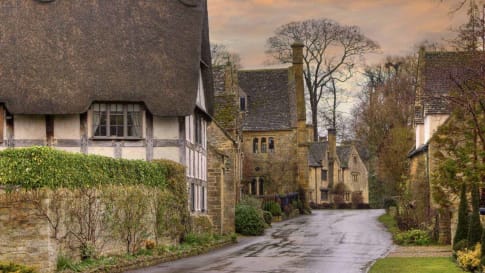
19 days
Jun, SepEngland’s villages small group history tours for mature travellers
Visiting England
Guided tour of the villages of England. The tour leader manages local guides to share their knowledge to give an authentic experience across England. This trip includes the UNESCO World heritage site of Avebury as well as villages in Cornwall, Devon, Dartmoor the border of Wales and the Cotswolds.
From A$16,995 AUD
View Tour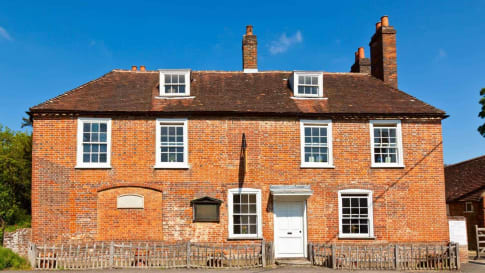
22 days
AugDiscovering the art and literature of England: Jane Austen, Shakespeare, and more
Visiting England
Stratford upon Avon, Shakespeares birthplace and Anne Hathaway's cottage as well as the Lake district a UNESCO World site and Dicken's London are part of guided tour for a small group tour of like minded people learning about the art and literature of England. Your tour leader and local guides share day tour itineraries to create a unique travel experience.
From A$17,765 AUD
View Tour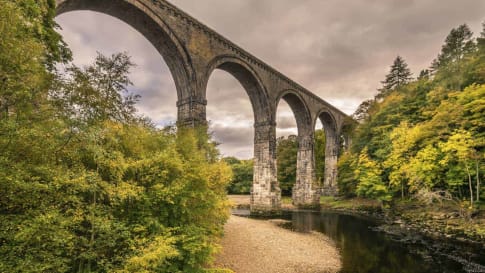
23 days
Oct, Apr, SepCanals and Railways in the Industrial Revolution Tour | Tours for Seniors in Britain
Visiting England, Scotland
A small group tour of Wales, Scotland & England that traces the history of the journey that is the Industrial revolution. Knowledgeable local guides and your tour leader share their history with you on this escorted tour including Glasgow, London, New Lanark & Manchester, Liverpool and the Lake district.
From A$17,860 AUD
View Tour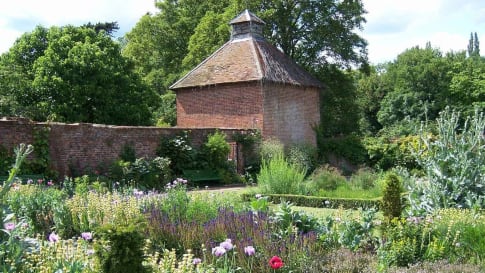
16 days
JunBritish Gardens Small Group Tour including Chatsworth RHS show
Visiting England, Scotland
From A$16,895 AUD
View Tour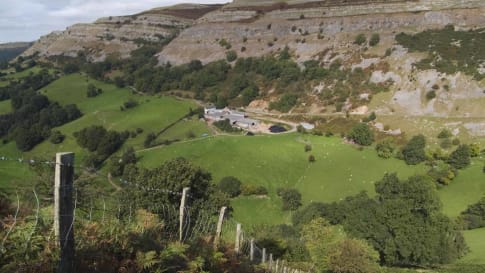
20 days
May, Sep, JunWalking Ancient Britain
Visiting England
A walking tour of England & the border of Wales. Explore on foot UNESCO World Heritage sites, Neolithic, Bronze age and Roman landscapes and the occasional Norman castle on your journey. Your tour director and tour guide walk you through the Brecon beacons, the Cotswolds and Welsh borders on this small group tour.
From A$13,995 AUD
View Tour
22 days
Sep, JunRural Britain | Walking Small Group Tour
Visiting England, Scotland
A walking tour into England, Scotland and Wales provides small group journeys with breathtaking scenery to destinations such as Snowdonia national park , the UNESCO world heritage site Hadrians wall and the lake district. each day tour provides authentic experiences often off the beaten path from our local guides.
From A$15,880 AUD
View Tour

